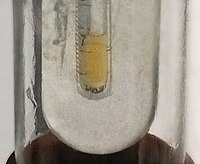
Photo from wikipedia
Domain structure often greatly affects piezoelectric performance of a ferroelectric ceramic. Accordingly, a convenient method that can well characterize the domain structure at various temperatures is highly desired for understanding… Click to show full abstract
Domain structure often greatly affects piezoelectric performance of a ferroelectric ceramic. Accordingly, a convenient method that can well characterize the domain structure at various temperatures is highly desired for understanding the underlying mechanism. An improved acid-etching technique was recently developed for such purpose. Domain structure of poled 0.96(K0.48Na0.52)(Nb0.96Sb0.04)O3–0.04(Bi0.50Na0.50)ZrO3 ceramics with a large piezoelectric coefficient d33 of 535 pC/N was systematically investigated at three typical temperatures. It was found that domain configurations change significantly with temperature. Hierarchical nanodomain structure is widely observed in domain patterns acid-etched at 25 °C, due to the orthorhombic-tetragonal phase coexistence. By contrast, the majority part of those acid-etched at − 60 °C are simply some long parallel stripes, while a small amount of banded structure appears in broad stripes inside some grains. A nearly 63° intersectional angle is seen between two adjacent sets of parallel stripes in the domain pattern of a cuboid-shaped grain, indicating that orthorhombic phase remains down to − 60 °C. The domain patterns acid-etched at 80 °C become even simpler, mainly consisting of long parallel stripes that are several hundred nanometers wide and have quite straight edges. Fundamental issues associating with the possible domain configurations and the acid-etching were discussed on the simple mathematical basis.
Journal Title: Scientific Reports
Year Published: 2020
Link to full text (if available)
Share on Social Media: Sign Up to like & get
recommendations!